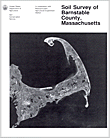The following is a map unit description from the "Soil Survey of Barnstable County, Massachusetts (Fletcher, 1993)"

Fm-Freetown mucky peat, 0 to 1 percent slopes, ponded. This very deep, level, very poorly drained soil is on outwash plains, on moraines, and in areas of glacial lake deposits. It is in depressions and in areas adjacent to streams, ponds, and lakes. Generally, 1 to 2 feet of water covers the surface for most of the year (fig. 1 0). Aquatic vegetation is on the surface. The soil makes up about 0.4 percent (1,063 acres) of the survey area. It is mapped throughout the county. Areas are irregularly shaped and range from 5 to 100 acres in size.
Typically, the surface layer is dark reddish brown mucky peat about 2 inches thick. Below this to a depth of 65 inches or more are alternating layers of dark reddish brown and very dusky red muck and mucky peat.
Included with this soil in mapping are small areas of Swansea soils and areas that are not covered by water. Included soils make up about 10 percent of this unit.
Permeability is moderate or moderately rapid throughout the Freetown soil. Available water capacity is very high.
Most areas support either emergent wetland vegetation or shrubby vegetation. This soil is unsuited to cultivated crops, hay, and pasture because of the ponding. Draining the soil is difficult because suitable outlets are not readily available and cannot be maintained.
This soil is unsuited to woodland because of the ponding, the wetness, a high seedling mortality rate, and a hazard of windthrow. Optimum growth and survival of seedlings are not expected. Because of the ponding and low soil strength, the use of equipment should be limited to periods when the soil is frozen. Generally, trees are not common on this soil, but some areas support Atlantic white cedar and red maple.
This soil is unsuited to most nonfarm uses because of the ponding and low strength in the organic material. Alternative sites should be selected.
This soil is well suited to wetland wildlife habitat. The common native plant communities provide adequate food and cover for nesting areas.